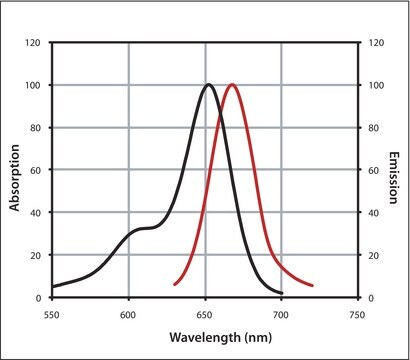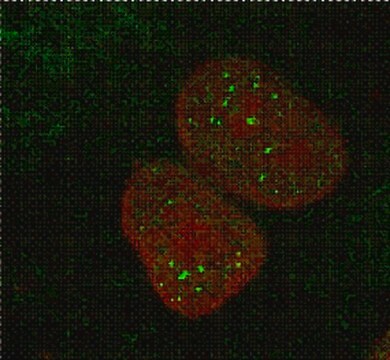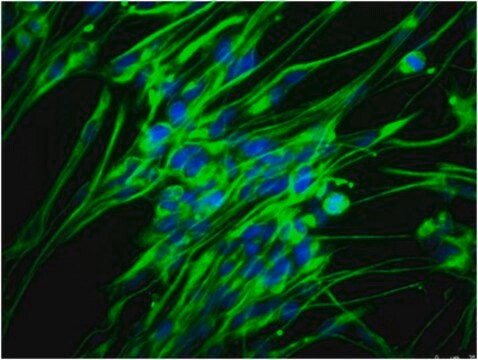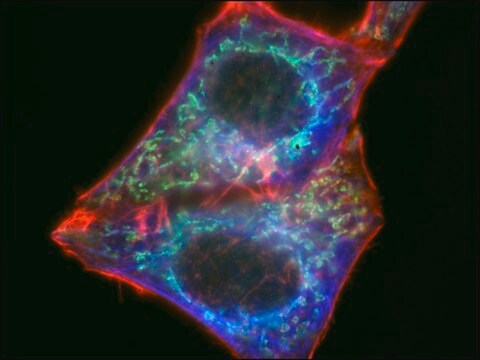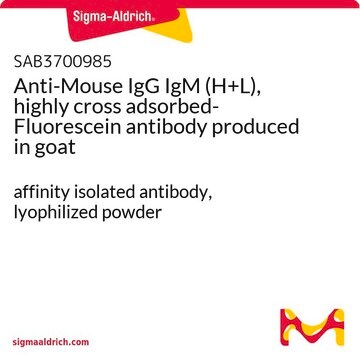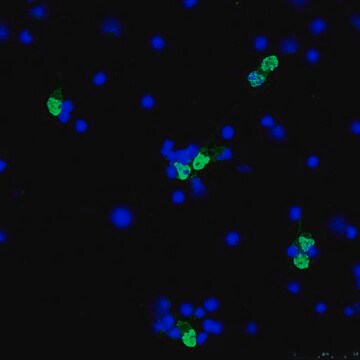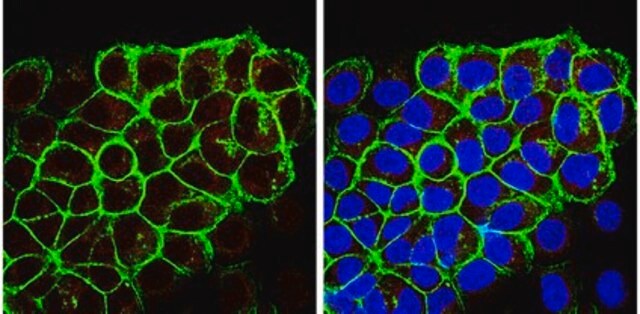추천 제품
생물학적 소스
rat
Quality Level
결합
ALEXA FLUOR™ 488
항체 형태
purified antibody
항체 생산 유형
primary antibodies
클론
13A4, monoclonal
종 반응성
mouse
반응하면 안 됨
Drosophila, rat, chicken, human
제조업체/상표
Chemicon®
기술
flow cytometry: suitable
입력
sample type epithelial cells
sample type hematopoietic stem cell(s)
sample type: mouse embryonic stem cell(s)
sample type mesenchymal stem cell(s)
sample type neural stem cell(s)
동형
IgG1κ
NCBI 수납 번호
UniProt 수납 번호
배송 상태
wet ice
타겟 번역 후 변형
unmodified
유전자 정보
chicken ... Prom1(422825)
human ... PROM1(8842)
mouse ... Prom1(19126)
rat ... Prom1(60357)
일반 설명
Prominin is a novel plasma membrane protein with an N-terminal extracellular domain, five transmembrane segments flanking two short cytoplasmic loops and two large glycosylated extracellular domains, and a cytoplasmic C-terminal domain. DNA sequences from Caenorhabditis elegans predict the existence of a protein with the same features, suggesting that prominin is conserved between vertebrates and invertebrates. Prominin is found not only in the neuroepithelium but also in various other epithelia of the mouse embryo. In the adult mouse, prominin has been detected in the brain ependymal layer, and in kidney tubules. In these epithelia, prominin is specific to the apical surface, where it is selectively associated with microvilli and microvilli-related structures. Remarkably, upon expression in CHO cells, prominin is preferentially localized to plasma membrane protrusions such as filopodia, lamellipodia, and microspikes. These observations imply that prominin contains information to be targeted to, and/or retained in, plasma membrane protrusions rather than the planar cell surface. Moreover, results show that the mechanisms underlying targeting of membrane proteins to microvilli of epithelial cells and to plasma membrane protrusions of non-epithelial cells are highly related (Weigmann et al., 1997). Also see (http://www.ncbi.nlm.nih.gov/prow/guide/438375806_g.htm) for more information on CD133 and prominin expression.
특이성
Recognizes mouse Prominin-1, a pentaspan transmembrane (5-TM) domain glycoprotein. Immunoblotting of E12 mouse brain and adult mouse kidney using mAb 13A4 showed that prominin has a mean apparent molecular weight of 115 kDa; Deglycosylation of brain and kidney prominin with peptide N-glycosidase F (PNGase F) yielded a 94-kDa band indicating that prominin is N-glycosylated. The additional 88-kDa band seen upon deglycosylation of brain prominin represents a C-terminally truncated form (Weigmann et al., 1997; Maw et al., 2000; Roper I, 2000). Prominin-1 is expressed on primitive cells such as hematopoietic stem and progenitor cells, neural & endothelial stem cells, retina and retinoblastoma, as well as developing epithelium. To date, the function and ligand of Prominin-1 are unknown. This antibody can be used to isolate murine stem cells from brain and bone marrow.
면역원
Telencephali of ten 12-day-old NMRI mouse embryos (E12, ~1 mg protein), which consist mostly of neuroepithelium, were homogenized in 1 mL PBS, mixed with crushed nitrocellulose filter (1 cm2 in 0.5 mL PBS) as adjuvant, and injected i.p. into a LouXSD rat (Weigmann et al., PNAS 1997).
애플리케이션
Immunohistochemistry: 1-15 μg/mL. Suggested fixatives: 2-4% PFA, or methanol -20°C fixation. When fixing cells in culture, incubate sample in 3% PFA for 15-30 min at room temperature. Tissue: perfusion with 2-4% PFA, 1-4 hours postfixation is typical. Traditional formalin fixation is NOT recommended. Permeabilization method: 0.2% saponin or 0.1-0.3% Triton X-100 in PBS. Blocking Buffer: For cells in culture, 0.2% gelatin in PBS; for tissue section, 10% FCS in PBS. Dilution Buffer: For cells in culture, 0.2% gelatin in PBS; for tissue section, 0.2% saponin and 10% FCS in PBS. Incubation Times/Temperature: Overnight at 4°C or 1 hour at 37°C.
Note: This antibody does not work with paraffin-embedded sections.
EM immunohistochemistry: The subcellular localization of the 13A4 antigen in mouse E9-10 neuroepithelial cells and adult kidney proximal tubule cells was investigated by immunogold electron microscopy. Strong labeling was observed over the kidney brush border membrane, where 13A4 immunoreactivity appeared to be concentrated toward the tips of the microvilli. Remarkably, in neuroepithelial cells, whose apical plasma membrane contains fewer microvilli than the kidney brush border, 13A4 immunoreactivity was associated mostly, if not exclusively, with microvilli and plasma membrane protrusions, and was not detected in the planar areas of the apical plasma membrane. Because of this preferential localization, the 13A4 antigen was referred to as ′′prominin′′ (from the Latin word ′′prominere,′′ to stand out, to be prominent) (Weigmann et al., 1997).
Western blotting: 1-5 μg/mL in 0.3% Tween in PBS. Sample preparation: Standard Laemmli (boiled in 2% SDS, 100mM DTT or 5% beta-mercaptoethanol, 60mM Tris-HCL pH 6.8). Preferred Gel percentage: 7.5%. Suggested Blocking Buffer: 3-5% Milk, 0.3% Tween in PBS. Incubation time: 1 hour at room temperature or overnight at 4°C. Recommended control extracts: Positive: Kidney membrane; Negative: liver membranes.
Immunoprecipitation: 10-25 μg/mL. Suggested tissue/cell lysis buffer: RIPA bufferFinal reaction volume: 500-1000 μL. Final total protein concentration in reaction mix: 0.5-3 mg/mL. Incubation times: overnight at 4°C. Capture agent used: Protein G Sepharose™ or rabbit anti-rat antibody/protein A Sepharose. Expected sizes on immunoblots (in kDa): 115 kDa (mature form) or 105 kDa (precursor form).
FACS Analysis: Suggested dilution/number of cells: 0.25-1 μg/ million cells. Fixation/Permeabilization used: BD FACS lysis Solution (1-1.5% formaldehyde) (BD and FACS are trademarks of Becton, Dickinson and Company) No permeabilization. Recommended controls: Hematopoietic stem cells.
Optimal working dilutions must be determined by the end user.
Note: This antibody does not work with paraffin-embedded sections.
EM immunohistochemistry: The subcellular localization of the 13A4 antigen in mouse E9-10 neuroepithelial cells and adult kidney proximal tubule cells was investigated by immunogold electron microscopy. Strong labeling was observed over the kidney brush border membrane, where 13A4 immunoreactivity appeared to be concentrated toward the tips of the microvilli. Remarkably, in neuroepithelial cells, whose apical plasma membrane contains fewer microvilli than the kidney brush border, 13A4 immunoreactivity was associated mostly, if not exclusively, with microvilli and plasma membrane protrusions, and was not detected in the planar areas of the apical plasma membrane. Because of this preferential localization, the 13A4 antigen was referred to as ′′prominin′′ (from the Latin word ′′prominere,′′ to stand out, to be prominent) (Weigmann et al., 1997).
Western blotting: 1-5 μg/mL in 0.3% Tween in PBS. Sample preparation: Standard Laemmli (boiled in 2% SDS, 100mM DTT or 5% beta-mercaptoethanol, 60mM Tris-HCL pH 6.8). Preferred Gel percentage: 7.5%. Suggested Blocking Buffer: 3-5% Milk, 0.3% Tween in PBS. Incubation time: 1 hour at room temperature or overnight at 4°C. Recommended control extracts: Positive: Kidney membrane; Negative: liver membranes.
Immunoprecipitation: 10-25 μg/mL. Suggested tissue/cell lysis buffer: RIPA bufferFinal reaction volume: 500-1000 μL. Final total protein concentration in reaction mix: 0.5-3 mg/mL. Incubation times: overnight at 4°C. Capture agent used: Protein G Sepharose™ or rabbit anti-rat antibody/protein A Sepharose. Expected sizes on immunoblots (in kDa): 115 kDa (mature form) or 105 kDa (precursor form).
FACS Analysis: Suggested dilution/number of cells: 0.25-1 μg/ million cells. Fixation/Permeabilization used: BD FACS lysis Solution (1-1.5% formaldehyde) (BD and FACS are trademarks of Becton, Dickinson and Company) No permeabilization. Recommended controls: Hematopoietic stem cells.
Optimal working dilutions must be determined by the end user.
Anti-CD133 Antibody, clone 13A4, Alexa Fluor 488 conjugated is an antibody against CD133 for use in FC.
Research Category
Stem Cell Research
Stem Cell Research
Research Sub Category
Neural Stem Cells
Hematopoietic Stem Cells
Neural Stem Cells
Hematopoietic Stem Cells
물리적 형태
Liquid in Phosphate buffer with 15 mg/mL BSA as a stabilizer and 0.1% sodium azide.
Protein A purified
저장 및 안정성
Maintain refrigerated at 2–8°C protected from light in undiluted aliquots for up to 24 months.
분석 메모
Control
Human embryonic stem cell lysate, Caco 2 (Human colonic carcinoma cell line) whole cell lysate
Human embryonic stem cell lysate, Caco 2 (Human colonic carcinoma cell line) whole cell lysate
기타 정보
Concentration: Please refer to the Certificate of Analysis for the lot-specific concentration.
법적 정보
ALEXA FLUOR is a trademark of Life Technologies
CHEMICON is a registered trademark of Merck KGaA, Darmstadt, Germany
Sepharose is a trademark of Cytiva
면책조항
Alexa Fluor™ is a registered trademark of Molecular Probes, Inc.
Unless otherwise stated in our catalog or other company documentation accompanying the product(s), our products are intended for research use only and are not to be used for any other purpose, which includes but is not limited to, unauthorized commercial uses, in vitro diagnostic uses, ex vivo or in vivo therapeutic uses or any type of consumption or application to humans or animals.
Unless otherwise stated in our catalog or other company documentation accompanying the product(s), our products are intended for research use only and are not to be used for any other purpose, which includes but is not limited to, unauthorized commercial uses, in vitro diagnostic uses, ex vivo or in vivo therapeutic uses or any type of consumption or application to humans or animals.
적합한 제품을 찾을 수 없으신가요?
당사의 제품 선택기 도구.을(를) 시도해 보세요.
Storage Class Code
12 - Non Combustible Liquids
WGK
WGK 2
Flash Point (°F)
Not applicable
Flash Point (°C)
Not applicable
시험 성적서(COA)
제품의 로트/배치 번호를 입력하여 시험 성적서(COA)을 검색하십시오. 로트 및 배치 번호는 제품 라벨에 있는 ‘로트’ 또는 ‘배치’라는 용어 뒤에서 찾을 수 있습니다.
D Corbeil et al.
The Journal of biological chemistry, 275(8), 5512-5520 (2000-02-22)
The human AC133 antigen and mouse prominin are structurally related plasma membrane proteins. However, their tissue distribution is distinct, with the AC133 antigen being found on hematopoietic stem and progenitor cells and prominin on various epithelial cells. To determine whether
D Corbeil et al.
Journal of cell science, 112 ( Pt 7), 1023-1033 (1999-04-13)
Prominin is a recently identified polytopic membrane protein expressed in various epithelial cells, where it is selectively associated with microvilli. When expressed in non-epithelial cells, prominin is enriched in plasma membrane protrusions. This raises the question of whether the selective
K Sawamoto et al.
The Journal of neuroscience : the official journal of the Society for Neuroscience, 21(11), 3895-3903 (2001-05-23)
Mesencephalic precursor cells may one day provide dopaminergic neurons for the treatment of Parkinson's disease. However, the generation of dopaminergic neurons from mesencephalic precursors has been difficult to follow, partly because an appropriate means for recognizing mesencephalic ventricular zone precursors
Christine A Fargeas et al.
Journal of cell science, 117(Pt 18), 4301-4311 (2004-08-19)
Prominin-1/CD133 is a five-membrane-span glycoprotein that is thought to act as an organizer of plasma-membrane protrusions. Here, we report the molecular and cell-biological characterization of four novel prominin-1 splice variants isolated from a mouse testis cDNA library and referred to
K Röper et al.
Nature cell biology, 2(9), 582-592 (2000-09-12)
Membrane cholesterol-sphingolipid 'rafts', which are characterized by their insolubility in the non-ionic detergent Triton X-100 in the cold, have been implicated in the sorting of certain membrane proteins, such as placental alkaline phosphatase (PLAP), to the apical plasma membrane domain
자사의 과학자팀은 생명 과학, 재료 과학, 화학 합성, 크로마토그래피, 분석 및 기타 많은 영역을 포함한 모든 과학 분야에 경험이 있습니다..
고객지원팀으로 연락바랍니다.
